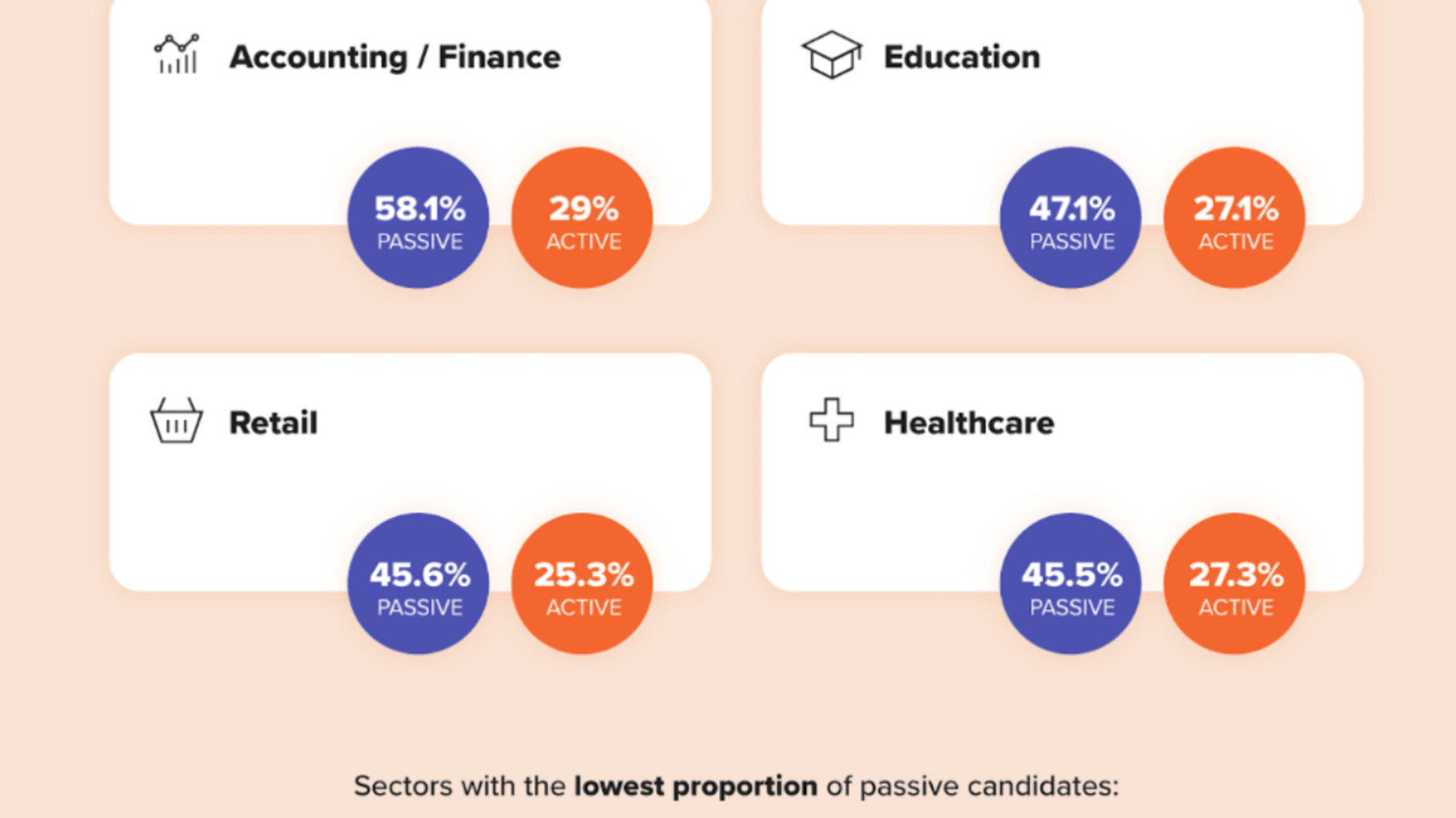Building a recruitment outreach process means you can reach out to the best candidates on the market, start conversations with them, and refer them to your clients with ease.
But, where do you get started?
In this guide, you’ll learn why you need to be running outreach rather than waiting for candidates to apply, and the six main steps involved when creating your own outreach process.
Let’s dive in.
What is Recruitment Outreach?
Recruitment outreach is the process of identifying and contacting candidates who look like a perfect fit for the roles that you’re hiring for.
It’s typically done over email, but other channels, such as LinkedIn outreach can also work.
What are the Benefits of Building a Recruitment Outreach Strategy?
1. Contact Passive Candidates
The first major benefit to recruitment outreach is that you can use it to engage with passive candidates.
In the US, this makes up over two-thirds of candidates, so it’s a demographic worth targeting.
Passive candidates aren’t actively looking for a role, so they won’t apply to open positions. As a recruiter, it’s your job to reach out to the best passive candidates and start a conversation.
It’s a powerful way to get high-quality candidates for every role, and it means you’re never sitting back waiting for the perfect person to apply, but instead, are being proactive and bringing the best people to your role.
2. Build a Candidate Network
As a recruiter, you need a strong network of candidates.
When a company asks you to fill a role, you can start by identifying the best-fit people in your existing network, and if there’s a fit, you could have people back to your client within days.
And, what’s the best way to build your network? Cold outreach.
You can run an ongoing cold email campaign where you reach out to a small selection of people in your industry to introduce yourself and learn about them.
As you build trust with people, candidates will directly reach out to you when they’re looking for a new job, and you’ll be able to go to your clients and let them know, increasing the odds of them hiring from your network.
It’s a powerful way to level up as a recruiter.
3. Fill Roles Faster Than the Competition
If you want clients to use your services again and again, there needs to be a benefit to them.
The biggest reason someone will keep using your services is if you can deliver them high-quality candidates faster than other recruiters can.
Having a recruitment outreach system in place means your clients won’t need to wait for qualified candidates to arrive at their job listings.
Instead, you can run your outreach, build a list of qualified candidates, and put them in touch with the hiring manager.
How to Run a Recruitment Outreach Process
1. Build Your Candidate List
First, you need to identify the right candidates to reach out to based on the role you’re hiring for.
The first place to start is LinkedIn.
LinkedIn’s upgraded Recruiter and Sales Navigator plans make identifying people matching your requirements easy.
For example, you could filter by people who:
- Are currently a Head of Growth or Head of Marketing
- Work in the IT and software industries
- Are based in a major city in the US
LinkedIn will then show you people who match those criteria.
You can save each potential candidate to lists so you stay organized, and when your list is ready, you can either export their emails from LinkedIn, or use a standalone email-finding tool.
If you see a high-potential candidate at this stage, you might even consider sending them a connection request and introductory message to break the ice.
You can use a LinkedIn-based CRM to keep track of your responses. If someone doesn’t respond, you can move on to the next step.
2. Write Your Email Templates
Once you have a list of potential candidates you want to contact, you’ll need a compelling email template.
This step is key because if you can quickly prove why your role is an ideal fit for their unique skills, you’ll get far more replies than if you sent a generic email template out to every candidate on your list.
To help your emails stand out, you need to add personalization.
This can be as simple as calling everyone by their name, referencing something about their current role, or mentioning that you were impressed by one of their projects.
The key is that it must be unique to them, and couldn’t be sent to anyone else.
All good recruitment outreach platforms will let you add personalization to your email templates.
These will automatically populate based on the information from your prospect list, making it easy to personalize your messages at scale.
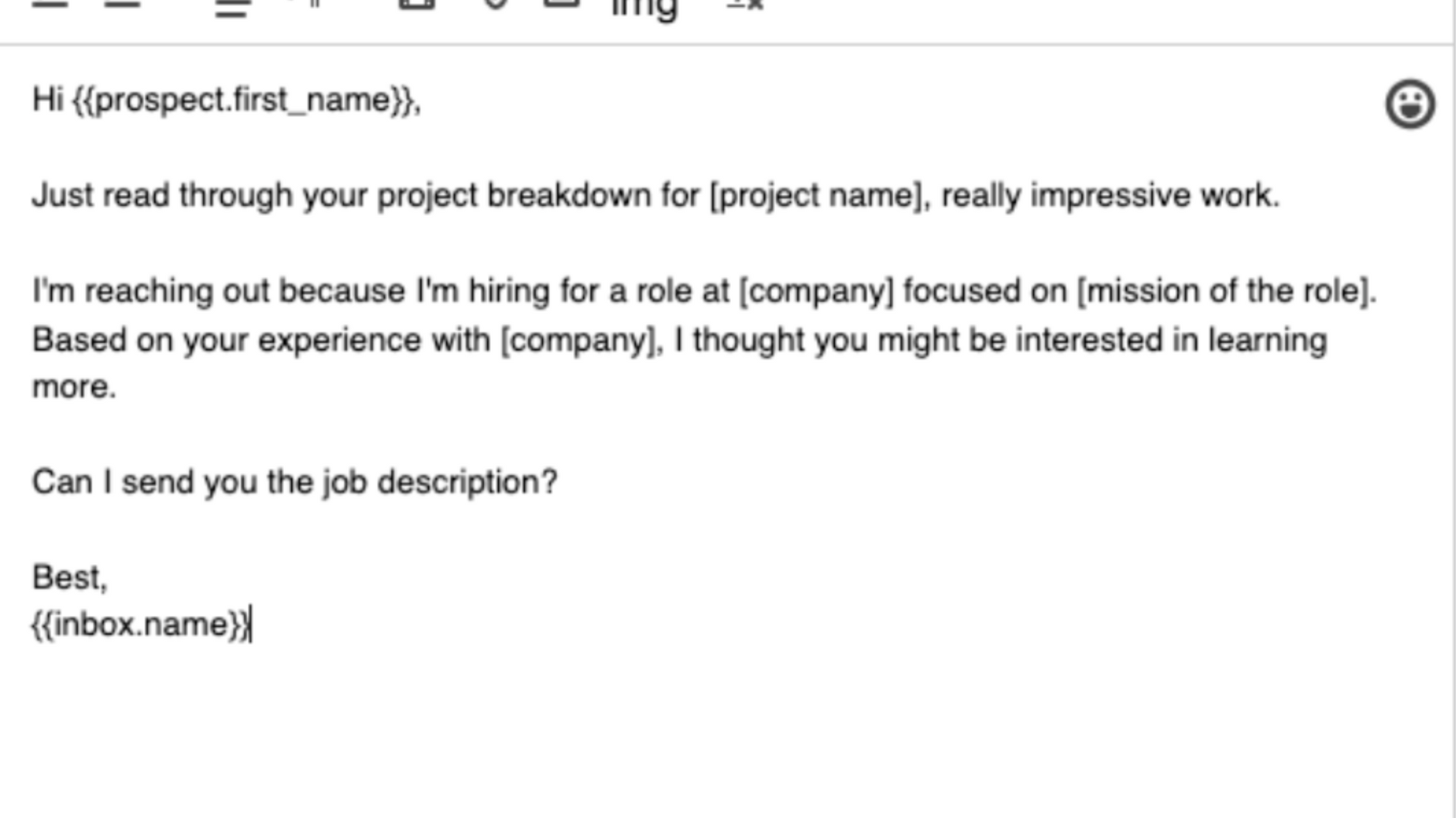
Next, you need to build trust.
The easiest way to do this is by adding social proof to your outreach template. For example, you could highlight how many other candidates that you’ve placed or share a testimonial that someone who you recently placed at a company left for you.
Finally, you’ll need a call-to-action (CTA).
Your CTA will guide the next steps of the interaction, so it’s important to think it through.
If you have a CTA that’s hard to respond to, it will drastically reduce your reply rate. On the other hand, if it’s simple and designed to start a conversation, such as a polite meeting invite or a simple question, they’ll be happy to respond.
For example, these CTAs are all excellent options:
- Do you have 15 minutes for an intro call this week?
- Can I send you the full job description?
- Are you open to opportunities like this at the moment?
The goal is to start a conversation with a candidate, and all of these will help you do that.
3. Schedule Your Email Campaign
Sending your outreach emails manually will take hours.
To speed up your recruitment process without compromising on personalization, you’ll need to use cold email sequence software.
These tools let you:
- Write one template with attributes and send personalized emails to multiple recipients at once
- Automatically follow up with people who don’t reply
- Track your key metrics such as open rate and reply rate
For example, you can use QuickMail to set up a campaign with multiple different email steps and touchpoints.
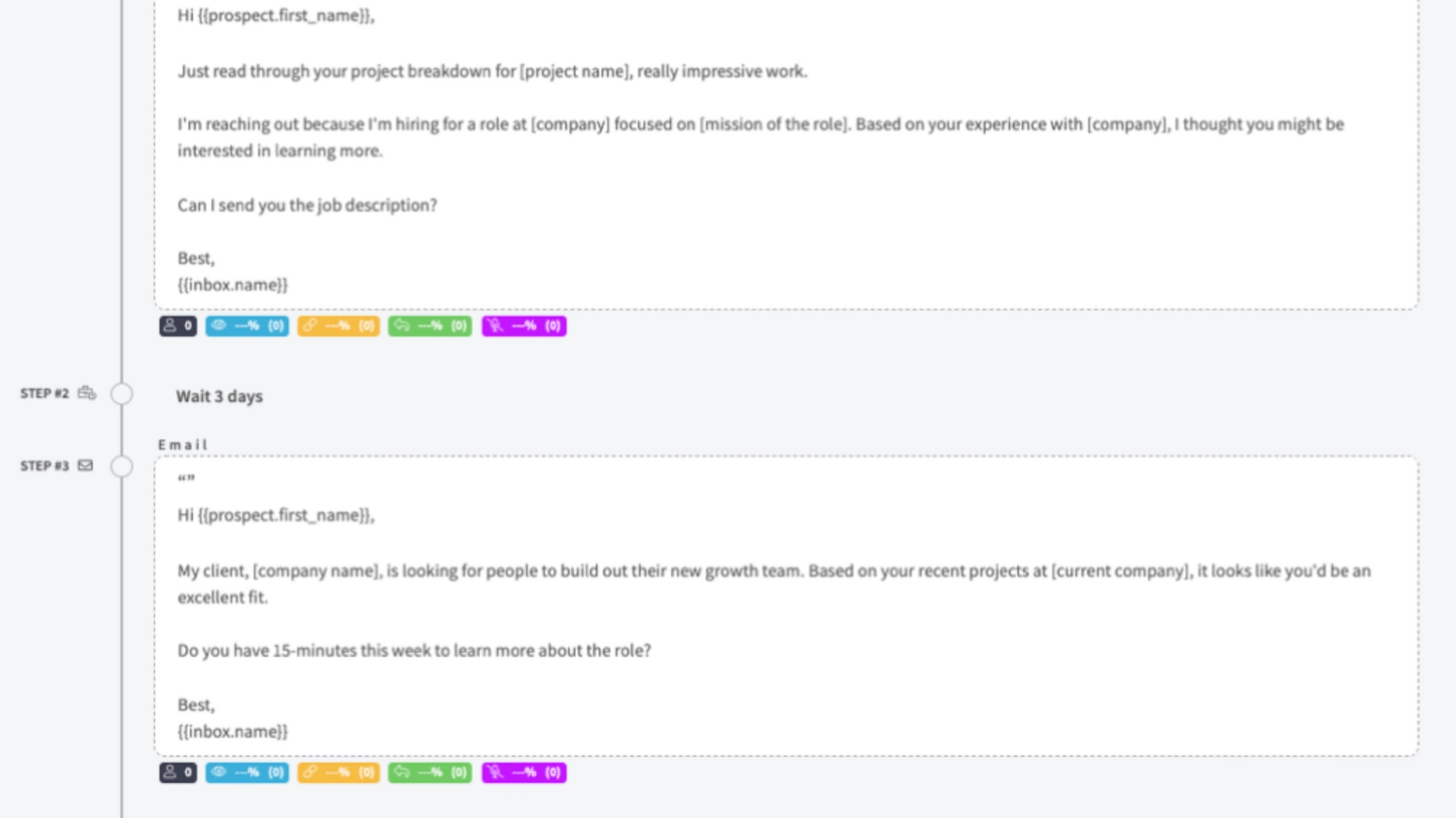
Once your campaign is ready, you’ll choose when to send it, and your outreach will be sent on autopilot.
4. Add Follow-Up Emails to Get More Replies
Even if a candidate you contact is a perfect fit, they won’t always reply at first.
Unfortunately, some candidates will ignore your first email, assuming you’ve sent hundreds of other candidates the same template.
To prove that you care about the relationship and that you think they’re a perfect fit for the role, you need to add at least one follow-up email to your campaign.
55% of replies to outreach come from a follow-up step, so it’s vital.
In your follow-up email, you’ll need to:
- Re-iterate why you’re reaching out
- Mention why they’re uniquely qualified
- Change your CTA to see if a lower or higher-commitment ask would work
You can easily add a follow-up email step in any cold email tool.
For example, in QuickMail, you’ll add a ‘Wait’ step after your first email, and choose your delay. In most cases, 3-5 days is enough.
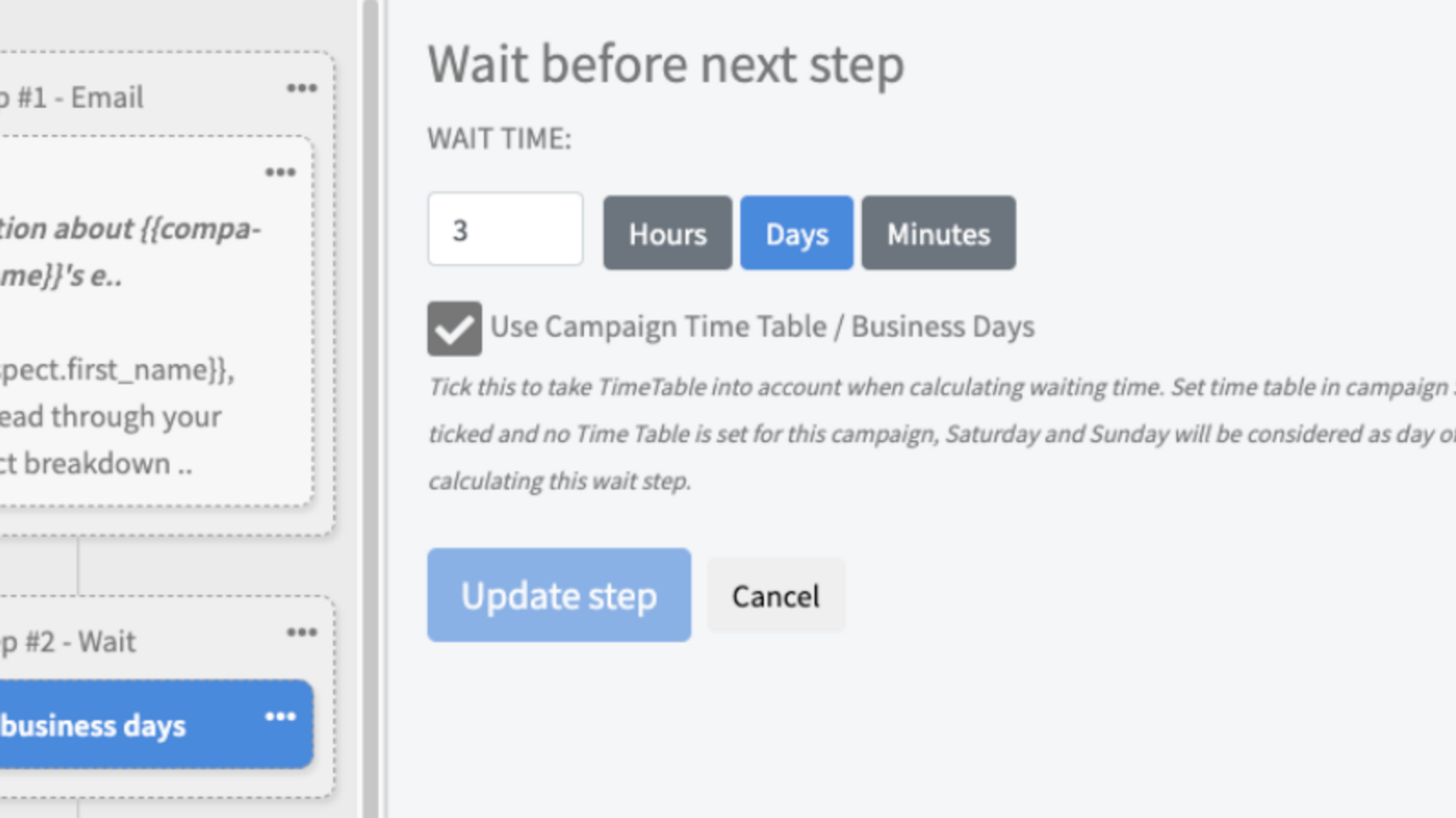
After that, you’ll add a new email step, and write your follow-up template.
It’s a powerful way to get more replies to your campaigns and have more conversations with qualified candidates.
5. Set Up Meetings with Candidates and Employers
Once you have a reply from a candidate, it’s time to get them set up with your client so they can learn more about the role and start the interview process.
Before you book any meetings, make sure you have your contracts in place so that if a candidate gets hired, you get your commissions for placing them.
When your client and potential candidates are ready, you can use a scheduling platform like Cronofy to arrange a time to meet that works for all parties.
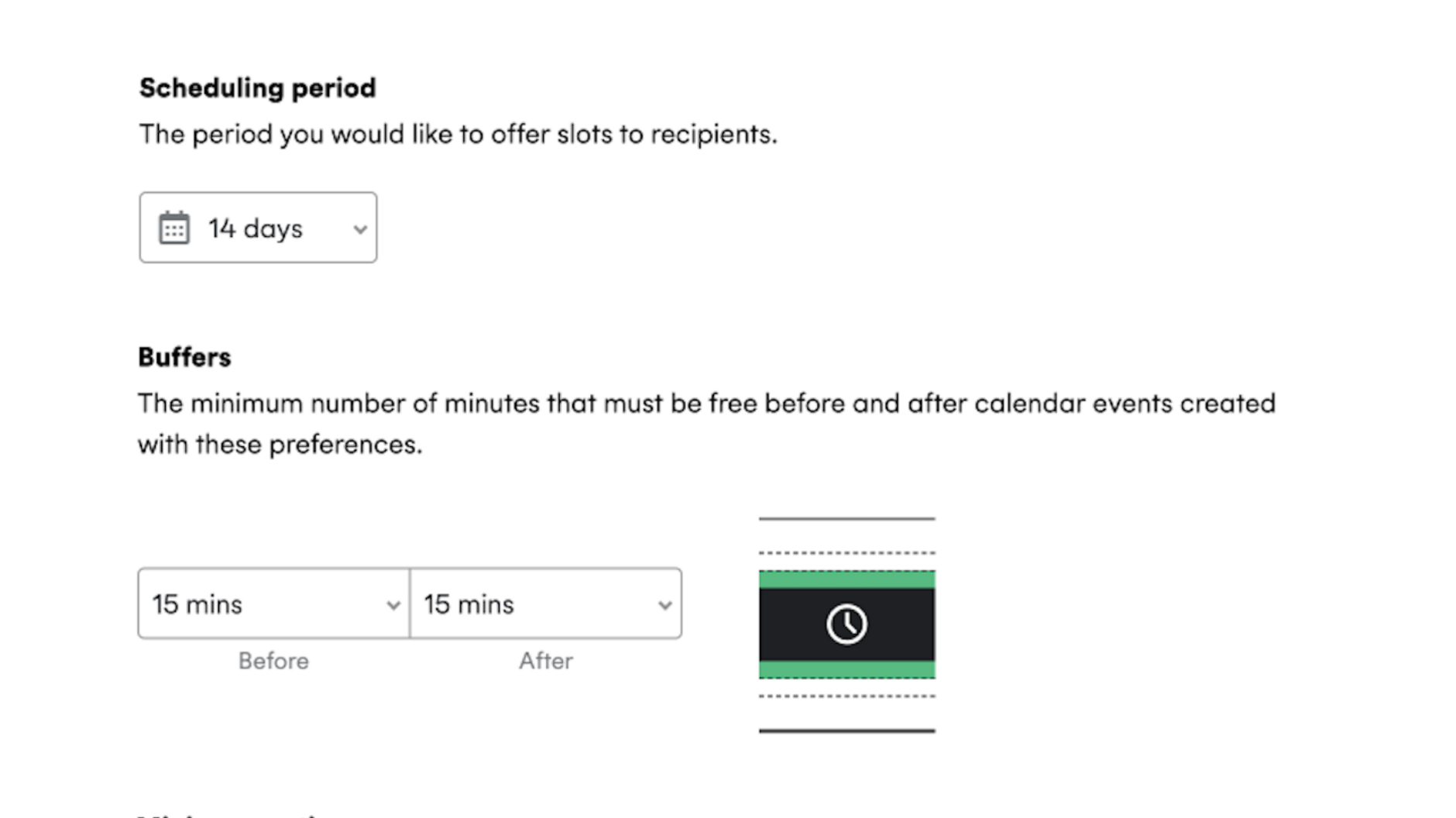
It makes the meeting scheduling process simple, as you can coordinate group meetings and invite external attendees to the meeting.
The links you send can be auto-populated with data on each person, which removes potential blockers to arranging a meeting. You can also integrate it with your calendars to automatically check availability, and link it to your meeting or calling tools.
This ensures that you’re not wasting time and can help your clients hire the best people without unnecessary delays in the process.
6. Track Your Results and KPIs
Over time, you’ll start to understand whether or not your process is working.
But, it’s important to track your key recruitment outreach metrics and overall KPIs.
This shows you if your campaigns are successful, or if there’s room to improve.
Here are some key metrics to track:
- Reply rate to email campaigns: Your reply rate shows you how good your email templates are, as well as how well-targeted your candidate list is. Aim for 10-20% at a minimum. If you see a reply rate that’s below that, or, if your replies are mostly negative, you’ll need to make changes to your emails.
- Email-to-meeting booking rate: This metric shows you how well you’re converting candidates who reply into hiring opportunities. You can use tools like Cronofy to streamline the meeting booking process and improve this metric.
- Candidate placement rate: This metric helps you understand how effectively you place candidates. It’s a reflection of how targeted your candidates lists are, how well you’re engaging candidates, and how many of your candidates your clients are hiring. It’s important to track because you can use it as social proof when pitching to new clients to show how effective your services are.
- Candidate attrition rate: This metric tells you how often candidates that you place are leaving their new jobs within a certain timeframe. If it’s too high, it’s a signal to improve your candidate prospecting process to identify people who are a better fit for the roles that you’re filling.
Of course, you can track more metrics than those we’ve looked above, but starting with these four will give you a strong foundation to understand the effectiveness of your recruitment outreach process.
In Summary
Creating a recruitment outreach process means you can consistently identify and start conversations with high-potential candidates.
Once you’ve started a conversation, you can start to make introductions to your clients and move the recruitment process forwards.
Building an outbound process means you don’t have to wait for the right candidates to come to you – instead, you’re proactively identifying the best person for every role.
If you follow the process we’ve outlined, you’ll be on your way to growing your candidate pipeline and successfully filling more roles.
Building a recruitment outreach process means you can reach out to the best candidates on the market, start conversations with them, and refer them to your clients with ease.
Jeremy is the founder of QuickMail.io, a SaaS company that enables personal one-to-one conversations at scale through automation – for outbound outreach, inbound leads, trial/onboarding, customer communication, and more. Before founding QuickMail, he worked for more than 15 years as a developer in the video game industry and in finance.


